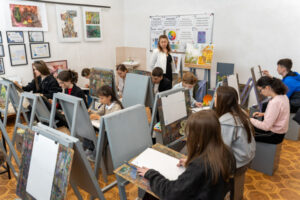The development of the E-NEVA electrocrospheres was frozen

The E-Neva electric crossover, which was created by the Almaz-Antei East Kazakhstan region, will not, as planned, will not be put into production in 2026 at the former Toyota plant. According to Kommersant's interlocutors, the project is frozen, the development did not receive funding, and in the conditions of “overloading with the main tasks” an electric crossover is not a priority for a military enterprise.
The project of the E-NEVA electrician development of the Almaz-Antei East Kazakhstan region, which was planned to be put on the conveyor of the former Toyota plant in Shushara in 2026, was frozen, and three sources in the industry told Kommersant. Initially, the concern took up the development of an electric car, says one of Kommersant's interlocutors in order to increase the share of civilian products in accordance with the instructions of the Russian authorities. However, now Almaz-Antei has other priorities, he adds. The fact that the concern was “overloaded with the main tasks” was reported last year by Vice Prime Minister Denis Manturov, although he noted that Almaz-Antey continues to develop E-Neva and production production plans in 2026 so far. The Almaz-Antee refused comments.
According to one of the sources of Kommersant, now the concern has neither its own funds or competencies for the implementation of such a project.
Another interlocutor of Kommersant recalls that the former Toyota plant transferred to the Diamaz-Antei department in April 2023, but the transaction to transfer the asset did not take place. The plant remained with us subordinate to the Ministry of Industry and Trade of FSUE. Several interlocutors of Kommersant noted that Almaz-Antee was asked for financing, but they were refused.
At the factory in Shushara, according to the data made in the published authorities, it is planned to release a new line of business class cars under the Aurus brand, together with a certain partner. Negotiations were conducted with Chinese Hongqi, the source of Kommersant clarifies. “When the plant was given to the Aurus projects, all E-Neva developments finally collapsed,” the source said. The third source “Kommersant”, familiar with the production plans of the plant, confirms that no work on the E-Neva electrocrospect is underway on the site. Another interlocutor recalls that now the concern has concentrated on another civilian project-the production of bases of bases on the former site for the production of MAN and Scania tractors in St. Petersburg.
The Ministry of Industry and Trade reported “Kommersant” that the E-Neva electrocrospector is still at the stage of the concept.
“In the event of a deeper study of the possibilities of its access to the industrial stage, the Ministry of Industry and Trade is ready to consider options for further development of the project, including in terms of the selection of a production site,” the ministry noted.
The E-Neva electric car project became known in 2021. The development was conducted by the specialists of the Obukhov plant (part of the Almaz-Antey East Kazakhstan Concern). The electric car was an electric crossover with a length of 4.5 m, the maximum speed was 197 km per hour, the declared mileage on one charge is 463 km. In 2022, the electric circuit was presented to Mr. Manturov, and in 2023 – Vladimir Putin. “I understand that a lot should be done. But do not quit, ”the President of the Russian Federation quoted RIA Novosti then.
Analysts and participants of the car market interviewed by Kommersant, in general, believe that now is not the best time to enter the market with their own electric car. One of the sources “Kommersant” gives an example of low sales of E-Largus. According to Avtostat, in January – February, sales of electric vehicles fell by 63%, up to 1.27 thousand pieces, while the entire car market – by 9.3%, up to 167.11 thousand units (See “Kommersant” from March 11). “The buyer is not ready to purchase electric vehicles in a massive order at a price of 3 million rubles, and E-Neva would have turned out to be expensive: there is no component base under it,” says Maxim Kadakov, editor-in-chief of the magazine Drive. In 2023, the possibility of involving an industrial partner was discussed, Denis Manturov said. But, according to Kommersant, cooperation did not take place. In 2025, analysts are waiting for the drop in the electric vehicle market in the Russian Federation by 30–40%.








/s3/static.nrc.nl/wp-content/uploads/2025/05/28114152/data132856299-1ef8b8.jpg)